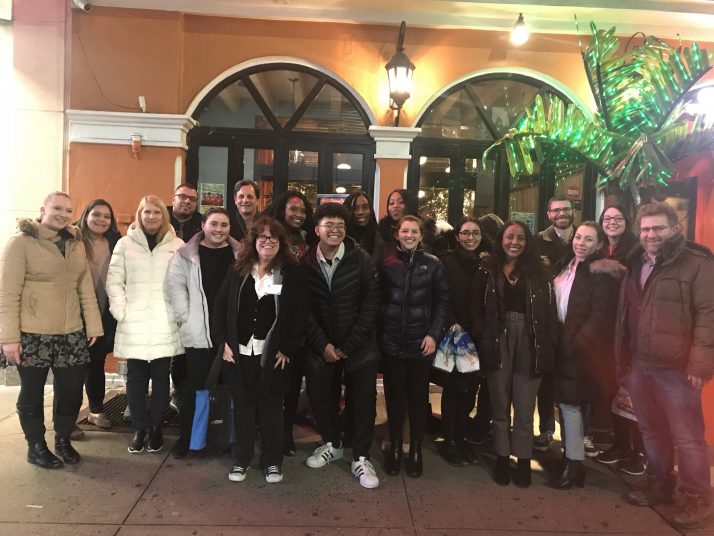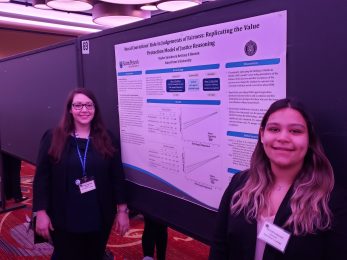Student & Faculty Research
Faculty Research Areas
Dr. Andrea Bubka
Areas of Specialty: Motion Perception, Motion Sickness, Memory and Ambiguity Processing
Since 2000, my main research interest has been in the areas of vection and motion sickness and the perceptual conflict factors that produce vection and motion sickness symptoms. This research is in collaboration with Frederick Bonato. In 2005 and 2006, we received NSF funding as well as a NASA grant allowing us to purchase equipment for our laboratory. Among the items purchased with these grants include an aircraft simulator and virtual reality system. The overall goal of our research is to explore causal factors associated with vection and motion sickness. Experiments have been conducted using a rotating optokinetic drum that contains the participant, a flight simulator, rear-projection screens, as well as head-mounted virtual reality equipment. In order to achieve vection, subjective spinning motion, one of the preceding experiences of motion sickness, a tilted drum has been used as well as a drum that changes speed. We have also manipulated complexity of the stimuli by comparing black/white stripes to a checkerboard pattern and also chromatic stripes. Cybersickness and immersion in 3D television viewing has also been explored. We have also conducted experiments involve adaptation with flight/space simulators with NASTAR researchers. University of Texas, Medical Branch was awarded an FAA grant to study the effects of future suborbital space flights. Our research team was led by Dr. Rebecca Blue, and we used a long-arm centrifuge located at NASTAR.
Dr. Joshua Feinberg
Areas of Specialty: Social Psychology, Industrial-Organizational Psychology
Dr. Feinberg specializes in research on social influences on workplace performance, perceptions of cheating in academics, sports, and business, and on decision making and morality.
Dr. Maryellen Hamilton
Area of Specialty: Memory
My primary research area is human memory. I study the types of conceptual processing that influence performance on implicit and explicit memory tests. I have also conducted research examining the phenomenology associated with conscious retrieval. My current research focuses on the cognitive differences between imaging and perceiving a picture and how these differences affect performance on implicit and explicit memory tests.
Dr. Brittany Hanson
Areas of Specialty: Moral and Political Attitudes
Does morality matter? Intuitively, it seems the answer is yes. However, one could argue that there are many attitudes people feel strongly about – ones that have considerable impact on our everyday lives – that are not morally relevant such as attitudes that reflect self-interest, matters of taste, or group memberships. My research focuses on investigating the antecedents and consequences of this moral/non-moral distinction. Specifically, I study what causes people to imbue some attitudes with moral relevance and whether seeing one’s political attitudes as morally relevant makes them any more impactful than other strong, but non-moral attitudes.
Dr. Leonor Lega
Areas of Specialty: Rational Emotive Behavior Therapy, Cross-Cultural Psychology
Cross cultural study (Spain, Latin America, Australia, India, and the U.S.) of irrational beliefs women have about traditional sex-role stereotypes from a cognitive-behavioral perspective.
Dr. Daniel Wisneski
Areas of Specialty: Moral Beliefs and Attitudes
I have three related but distinguishable programs of research that explore (1) what causes people to view social phenomena through the lens of their moral beliefs (i.e., the process of moralization), (2) individual differences in the tendency to moralize within the political (versus non-political) domain, and (3) how adopting a moral frame of mind can motivate political engagement and activism.
Eastern Psychological Association 2019 – NYC

Race and Morality: How Implicit Prejudice Affects Moral Decisions in Trolley Problem

Gillian Bartzak, Joshua Feinberg, Rabia Haroon (Saint Peter’s University)
Participants were presented with the Trolley problem in which the race (Black or Caucasian) of the sets of “victims” varied by condition. Participants also completed a race IAT to measure implicit racial preference. The results of the study found that participants were more likely push the Caucasian bystander and save the African American victims on the track. The post-task questionnaire responses indicated that race did affect their moral decisions in the Trolley Problem.
Framing Impacts Decision Time for The Trolley Car Problem

Dakota Bonanno (Saint Peter’s University), Michelle Vinitmilla (Hudson County Community College), Maryellen Hamilton (Saint Peter’s University)
The current study investigated the effect of framing on the Trolley Car Problem. Two variations of the problem were used, five people or fifteen people on the track. The problem was also framed in one of three ways (Positive, Neutral, Negative). A significant interaction was found between the number of individuals presented on the track and the frame used. Participants in the fifteen people, negative frame condition showed significantly faster decision times than other conditions.
Does Sound Enhance Perceived Self-Motion in Virtual Reality?

Andrea Bubka, Katherine Angeles, Frederick Bonato (Saint Peter’s University)
Using the Oculus Rift, participants experienced a ride through rooms with unrelated music and in silence to assess the effect sound has on perceived self-motion (vection) in virtual reality. Vection was assessed using a 0-10 scale with 0 indicating no self-motion and 10 indicating maximum self-motion was perceived. The mean rating after the sound condition was higher than the no-sound condition. The voluminous nature of sound may add to the 3D perception of the display.
Exploring Libertarian Morality in The Moral Motives Model

Petra Calderon, Daniel Wisneski (Saint Peter’s University)
The current exploratory study sought to see where libertarian values would fit into the Moral Motives Model (Janoff-Bulman, & Carnes, 2013). If Libertarians place value on the self, liberty, and personal freedom, then they should fall under the self (personal) moral motives related to self-restraint and industriousness. Results showed that each of these motives was endorsed most by either traditional conservatives (for industriousness) or social conservatives (for self-restraint) rather than by libertarians.
Negativity Bias in Projecting Outcomes of Real-World Events

Diego Jones, Anthony Martinez, Brittany Hanson (Saint Peters University)
We examined negativity bias in perceptions of a real-world political event, the Supreme Court hearing cases involving the legal status of same-sex marriage. Consistent with the negativity bias hypothesis, people saw the attitude inconsistent outcome of the cases as more harmful then they saw the attitude consistent outcome as beneficial.
Testing a Difference-Education Intervention on First-Generation College Students

Peter Saad, Daniel Wisneski, Maryellen Hamilton (Saint Peters University)
The current study sought to replicate and extend past research showing the effectiveness of a “difference-education” intervention on improving the academic performance of first generation college students. Specifically, we tested the intervention’s effectiveness among a sample of high minority, STEM majors. Initial results found no effect of the intervention on participants’ feelings of efficacy following the intervention, the perceived usefulness/enjoyment of the intervention, or their GPAs at the end of their first year.
Moral Convictions’ Role in Judgements of Fairness: Replicating the Value Protection Model of Justice Reasoning

Taylor Sanchez, Brittany Hanson (Saint Peter’s University)
We examined reactions to the U.S. Supreme Court pre- and post-ruling on the legal status of same-sex marriage. Consistent with Skitka & Mullen’s (2002) Value Protection Model of Justice Reasoning, people’s post-ruling perceptions decision fairness and acceptance were shaped by whether the outcome was consistent with their moral convictions about same-sex marriage. Furthermore, morally convicted beliefs explain more variance in decision fairness and acceptance compared to pre-ruling perceptions of the procedural fairness of the Court.
